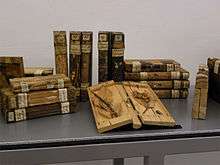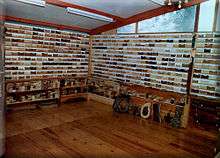Xylotheque
A xylotheque or xylothek (from the Greek xylon for "wood" and "theque" meaning "repository") is special form of herbarium that consists of a collection of authenticated wood specimens.[1] It is also known as a xylarium (from the Greek xylon for "wood" and Latin "arium" meaning "separate place"). Traditionally, xylotheque specimens were in the form of book-shaped volumes, each made of a particular kind of wood and holding samples of the different parts of the corresponding plant. While the terms are often used interchangeably, some use xylotheque to refer to these older collections of wooden 'books' and xylarium for modern collections in which some or all of the specimens are in simpler shapes, such as blocks or plaques with information engraved on their surfaces.[1] Many countries have at least one xylotheque with native flora, and some also house flora from other parts of the world. They are valuable to specialists in forestry, botany, conservation, forensics, art restoration, paleontology, archaeology, and other fields.[2]

History
Xylotheques date back to the later 17th century, when wood specimens began to appear in cabinets of curiosity.[3] Over time, they grew larger and more systematic, with hundreds of individual volumes in a single collection. The oldest extant collection was established in 1823 at the University of Leningrad, and by the middle of the century they had been established in many European countries.[1][3][4] Australia now houses 12 xylaria holding 11% of the world's wood specimens,[4] while the Oxford Forestry Institute's xylarium holds about 13%.[1]
In older xylotheques, the wooden volumes were typically made out of the same wood as the specimens inside and sometimes decorated with tree bark and associated lichens and mosses.[3] Each volume housed seeds, flowers, twigs, and leaves from the corresponding tree or bush, along with a written description hidden in a small compartment set into the inner spine. An alternative form of xylotheque found in Japan and elsewhere featured paintings of the plant parts rather than actual field specimens.[3]
Even a modest collection of wood samples has value, as each of its samples has a particular history. Xylotheques provide comparison samples for xylotomy, art historical studies, and scientific studies of the physical and mechanical properties of wood, such as durability and preservation. Xylotheques are also useful for anyone who needs to make a morphological-visual analysis of wood.
The xylotheque with the largest number of samples is the Samuel James Record Collection in the United States, which holds 98,000 samples. Formerly housed at the Forestry School of Yale University in New Haven, Connecticut, it was transferred to the U.S. Forest Service's Forest Products Laboratory in 1969.[1][5] The second largest xylotheque belongs to the Royal Museum of Central Africa in Tervuren, Belgium, with 57,000 samples.[1] The Thünen Institute of Wood Research in Hamburg has more than 37,000 samples.[6]
Selected xylotheques
| Xyloteque | Samples |
| Xylarium Bogoriense, Bogor (Indonesia) | 187,657[7] |
| Madison, Wisconsin (United States) | 98,000[1] |
| Tervuren (Belgium) | 57,000[1] |
| Hamburg (Germany) | 37,000[6] |
| RBG Kew (UK) | 34,000[8] |
| São Paulo (Brazil) | 17,000[9] |
| Beecroft (Australia) | 13,000[9] |
Index xylariorum
The Index xylariorum is a listing of the world's xyleria. It was conceived of by William Louis Stern (1926 - ) who first published the work in 1967.[10] A subsequent work in 1981 was published by the Botanic Garden of the Polish Academy of Sciences as "No. 1" of the series.[11] Stern then published the third revised edition of this work in 1988.[12] Anna H. Lynch and Peter E. Gasson compiled Index Xylariorum 4.1 in 2010, and the International Association of Wood Anatomists updated the list in 2016 under the supervision of Frederic Lens.[13] In addition to the link to the PDF of this document provided in the reference list of this article, Index Xylariorum 4.1 can also be accessed online as a database through the Global Timber Tracking Network website here.
Below is a list of the Index xylariorum codes, locations, and institutional names included by Stern in his 1988 Index xylariorum.[12] This list is provided for historic context.
Collapsed list of historic Index xylariorum codes and locations from 1988 publication[12] | ||||||||||||||||||||||||||||||||||||||||||||||||||||||||||||||||||||||||||||||||||||||||||||||||||||||||||||||||||||||||||||||||||||||||||||||||||||||||||||||||||||||||||||||||||||||||||||||||||||||||||||||||||||||||||||||||||||||||||||||||||||||||||||||||||||||||||||||||||||
|---|---|---|---|---|---|---|---|---|---|---|---|---|---|---|---|---|---|---|---|---|---|---|---|---|---|---|---|---|---|---|---|---|---|---|---|---|---|---|---|---|---|---|---|---|---|---|---|---|---|---|---|---|---|---|---|---|---|---|---|---|---|---|---|---|---|---|---|---|---|---|---|---|---|---|---|---|---|---|---|---|---|---|---|---|---|---|---|---|---|---|---|---|---|---|---|---|---|---|---|---|---|---|---|---|---|---|---|---|---|---|---|---|---|---|---|---|---|---|---|---|---|---|---|---|---|---|---|---|---|---|---|---|---|---|---|---|---|---|---|---|---|---|---|---|---|---|---|---|---|---|---|---|---|---|---|---|---|---|---|---|---|---|---|---|---|---|---|---|---|---|---|---|---|---|---|---|---|---|---|---|---|---|---|---|---|---|---|---|---|---|---|---|---|---|---|---|---|---|---|---|---|---|---|---|---|---|---|---|---|---|---|---|---|---|---|---|---|---|---|---|---|---|---|---|---|---|---|---|---|---|---|---|---|---|---|---|---|---|---|---|---|---|---|---|---|---|---|---|---|---|---|---|---|---|---|---|---|---|---|---|---|---|---|---|---|---|---|---|---|---|---|---|---|---|---|---|
|
In popular culture
For documenta 13 in 2012, American artist Mark Dion created a new hexagonal display chamber for the Schildbach Xylotheque at the Natural History Museum in Kassel, Germany. As part of the project, he created six new volumes made of wood from each of the continents (excluding Antarctica).[14]
See also
- List of woods
- Arboretum
- Botanical gardens
Notes
- "Xylarium" Claude E. Phillips Herbarium, Delaware State University.
- "Xylarium". Kerala Forest Research Institute.
- Lovejoy, Bess. "Xylotheks: Wondrous Wooden Books That Hold Wooden Collections". Atlas Obscura, May 22, 2014.
- Hopewell, Gaz. "The Queensland Government Xylaria". Department of Agriculture and Fisheries, Queensland Government.
- "Forest Products Laboratory - USDA Forest Service". www.fpl.fs.fed.us. Retrieved 2015-09-21.
- "Service for Timber Trade Associations and Consumers". Thünen Institute.
- "Ministry to name Bogor's Xylarium world's largest wood collection". The Jakarta Post. Retrieved 22 September 2018.
- "Wood collection (xylarium)", Kew Royal Botanic Gardens.
- "FAO Forestry Paper 71". Food and Agriculture Organization of the United Nations, 1986.
- Stern, William Louis (1967). Index xylariorum: institutional wood collections of the world (1st ed.). Utrecht: International Bureau for Plant Taxonomy and Nomenclature of the International Association for Plant Taxonomy. OCLC 460416.
- Index Xylariorum. No. 1, 1980-1981. Warsaw: Botanic Garden of the Polish Academy of Sciences. 1981. OCLC 82560516.
- Stern, William Louis (1988). Index xylariorum: institutional wood collections of the world (3rd ed.). Leiden: Rijksherbarium for the International Association of Wood Anatomists. OCLC 19862369.
- Lynch, Anna H.; Gasson, Peter E.; Lens, Frederic (March 2010) [Updated: March 2016]. Index Xylariorum 4.1 (PDF) (Report). International Association of Wood Anatomists. Retrieved 7 June 2019 – via www.iawa-website.org.
- Brindley, Jack. "Mark Dion - The Schildbach Xylotheque 'Wood Library'". Open File, Aug. 6, 2012.
External links
- Xiloteca Manuel Soler — one of the largest private xylotheques
- Wood Collection Xiloteca Imanol Artola (Zumárraga, España) — a Spanish xylotheque
